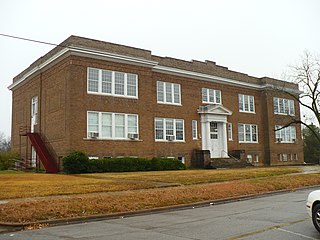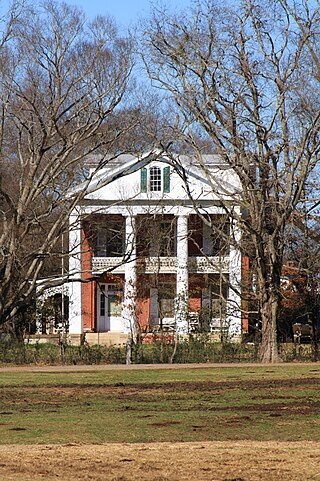
Marengo County is a county located in the west central portion of the U.S. state of Alabama. As of the 2020 census, the population was 19,323. The largest city is Demopolis, and the county seat is Linden. It is named in honor of the Battle of Marengo near Turin, Italy, where French leader Napoleon Bonaparte defeated the Austrians on June 14, 1800.

Demopolis is the largest city in Marengo County, in west-central Alabama. The population was 7,162 at the time of the 2020 United States census, down from 7,483 at the 2010 census.

Linden is a city in and the county seat of Marengo County, Alabama, United States. The population was 1,930 at the 2020 census, down from 2,123 at the 2010 census.

The Battle of Hohenlinden was fought on 3 December 1800 during the French Revolutionary Wars. A French army under Jean Victor Marie Moreau won a decisive victory over an Austrian and Bavarian force led by 18-year-old Archduke John of Austria. The allies were forced into a disastrous retreat that compelled them to request an armistice, effectively ending the War of the Second Coalition. Hohenlinden is 33 km east of Munich in modern Germany.

François Antoine "Charles" Lallemand was a French general who served Napoleon I of France, tried to found a colony in what is now Texas, and finally returned to France to serve as governor of Corsica.

The Fighting Kentuckian is a 1949 American Adventure Western film written and directed by George Waggner and starring John Wayne, who also produced the film. The supporting cast featured Vera Ralston; Philip Dorn; Oliver Hardy portraying Wayne's portly sidekick; Marie Windsor; John Howard; Hugo Haas; Grant Withers and Odette Myrtil.

Bluff Hall is a historic residence in Demopolis, Alabama, United States. The original portion of the house is in the Federal style with later additions that altered it to the Greek Revival style. It was documented as part of the Historic American Buildings Survey in 1936, and added to the National Register of Historic Places in 1970. It serves as a historic house museum, with the interior restored to an 1850s appearance.

The Demopolis Historic Business District, currently officially known as Demopolis Historic District, is a historic district in the city of Demopolis, Alabama, United States. Demopolis had its beginnings in 1817 with the Vine and Olive Colony. The historic district is a ten block area, roughly bounded by Capitol Street, Franklin Street, Desnouettes Street, and Cedar Avenue.

Demopolis Town Square, currently officially known as Confederate Park, is a historic park in the city of Demopolis, Alabama, United States. It is one of the oldest public squares in the state. Demopolis had its beginnings in 1817 with the Vine and Olive Colony, and the park was established in 1819. The park covers one city block, bounded by Main, Capitol, Walnut, and Washington Streets.

White Bluff, also known as Ecor Blanc, is a historic site located along the Tombigbee River in Demopolis, Alabama. It is a chalk cliff, roughly one mile long, that is composed of a geological layer known as the Demopolis Chalk Formation, part of the Selma Group. The upper portions of the cliff stood almost 80 feet (24 m) above the river before the construction of the Demopolis Lock and Dam downriver. It now averages about 30 feet (9.1 m) above the river.

Ashe Cottage, also known as the Ely House, is a historic Carpenter Gothic house in Demopolis, Alabama. It was built in 1832 and expanded and remodeled in the Gothic Revival style in 1858 by William Cincinnatus Ashe, a physician from North Carolina. The cottage is a 1+1⁄2-story wood-frame building, the front elevation features two semi-octagonal gabled front bays with a one-story porch inset between them. The gables and porch are trimmed with bargeboards in a design taken from Samuel Sloan's plan for "An Old English Cottage" in his 1852 publication, The Model Architect. The house is one of only about twenty remaining residential examples of Gothic Revival architecture remaining in the state. Other historic Gothic Revival residences in the area include Waldwic in Gallion and Fairhope Plantation in Uniontown. Ashe Cottage was added to the Alabama Register of Landmarks and Heritage on August 22, 1975, and to the National Register of Historic Places on 19 October 1978.

Altwood is a historic plantation house located near Faunsdale, Alabama. It was built in 1836 by Richard H. Adams and began as a log dogtrot house. It was then expanded until it came to superficially resemble a Tidewater-type cottage. Brought to the early Alabama frontier by settlers from the Tidewater and Piedmont regions of Virginia, this vernacular house-type is usually a story-and-a-half in height, displays strict symmetry, and is characterized by prominent end chimneys flanking a steeply pitched longitudinal gable roof that is often pierced by dormer windows.

The Demopolis Public School also known as Demopolis Junior High School is a historic public school building in the city of Demopolis, Alabama. It was designed by architect Frank Lockwood in the Beaux-Arts style and was completed in 1914. The new two-story brick building replaced an earlier two-story Queen Anne style wood-frame structure that was built in 1889 and burned in 1913. The contractors for the new building were J.T. Clancy and W.M. Neely. The building continued as a part of the Demopolis City School System until it closed its doors in June 1981. The school was added to the National Register of Historic Places on October 28, 1983. The building now houses a theater group, the Canebrake Players.

Bermuda Hill, also known as the Liver House, is a historic plantation house in Hale County, Alabama near Prairieville, Alabama. It was added to the National Register of Historic Places on July 7, 1994, as a part of the Plantation Houses of the Alabama Canebrake and Their Associated Outbuildings Multiple Property Submission.

The Alfred Hatch Place at Arcola, also known as the Arcola Plantation and locally as the Half-house, is a historic plantation house and historic district on the Black Warrior River several miles northwest of Gallion, Alabama.

Champ d'Asile was a short-lived settlement founded in Texas in January 1818 by 20 French Bonapartist veterans of the Napoleonic Wars from the Vine and Olive Colony. The party was led by General Charles Lallemand. Land was offered to French settlers on March 3, 1817, after a vote by the United States Congress. Champ d'Asile was situated along the Trinity River and was abandoned in July of the same year.

Arcola is a ghost town on the Black Warrior River in what is now Hale County, formerly Marengo County, Alabama. Named to honor the French victory during the Battle of Arcola, it was established in the early 1820s by former French Bonapartists as part of their Vine and Olive Colony, after they were forced to abandon their first town at Demopolis and many found Aigleville unsuitable. The first settler at the site was Frederic Ravesies, who established himself at what later became the Hatch Plantation. Although never more than a village, Arcola became the largest settlement in the colony. Beginning in the 1830s American settlers moved into the area and purchased most of the former French land grants, primarily using Arcola as a river landing. By the 1850s the French settlement had disappeared, replaced by a community of adjoining plantations.

Aigleville, literally translated as Eagle Town, was a town on the Black Warrior River in Marengo County, Alabama, United States that is now a ghost town. The settlement was established in late 1818 by former French Bonapartists and refugees from Saint-Domingue, as a part of their Vine and Olive Colony. It was named in honor of the French Imperial Eagle, the standard used by the Grande Armée of Napoleon I, and is now within the city of Demopolis.
L'Abeille américaine, Journal Historique, Politique, et Litteraire à Philadelphie was an American French language newspaper, based in Philadelphia The weekly newspaper, published by A.J. Blocquerst, began publication in 1815. The founder of the newspaper, Jean Simon Chaudron, had escaped from Santo Domingo (Saint-Domingue).
Jacques Garnier, also called Garnier de Saintes, was born in Saintes on 30 March 1755, and drowned in the Ohio river in 1817 or 1818 was a French politician, a lawyer and a revolutionary.

















